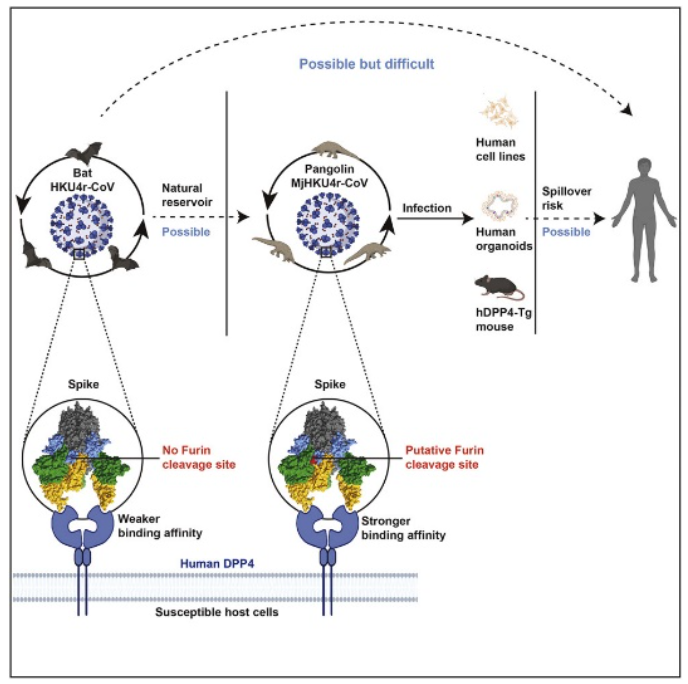On February 16, 2023, the top international academic journal Cell published online a research paper titled "A bat MERS-like coronavirus circulates in pangolins and utilizes human DPP4 and host proteases for cell entry," reporting on the molecular mechanism of a new MERS-related coronavirus (Manis javanica HKU4-related coronavirus, MjHKU4r-CoV) infecting human cells. Li Jing, a doctoral student at Beijing University of Chemical Technology, was listed as a co-first author of the article, and Professor Tong Yigang from the School of Life Science and Technology was listed as a co-corresponding author. The collaborative research partners included the Wuhan Institute of Virology, Chinese Academy of Sciences/Guangzhou Laboratory, Guangxi Medical University, Fudan University, among others.

The MjHKU4r-CoV virus was discovered in the Malayan pangolin. As the most trafficked mammal, the role of pangolins in the interspecies transmission of bat coronaviruses remains unclear. In this study, a pan-CoV PCR detection targeting the RNA-dependent RNA polymerase (RdRp) gene of coronaviruses, coupled with next-generation sequencing, identified a novel MERS-related coronavirus closely related to bat HKU4-CoV, named MjHKU4r-CoV-1. Evolutionary analysis classified MjHKU4r-CoV-1 as a member of the Merbecovirus subgenus, within the bat HKU4 coronavirus species. The receptor-binding motif (RBM) in the spike (S) protein of MERS-CoV contains 16 key residues crucial for binding to hDPP4. A comparison with MERS-CoV revealed 8 conserved residues in the receptor-binding domain (RBD) of MjHKU4r-CoV-1. Further analysis indicated potential similarities between a putative furin cleavage site (RQQR) in subdomain 1 (SD1) of the S protein of MjHKU4r-CoV-1 and that in MERS-CoV, suggesting a possible interaction with hDPP4. The researchers successfully isolated the MjHKU4r-CoV-1 coronavirus and demonstrated its entry into cells using hDPP4 as a receptor through infection of Huh-7 cells with DPP4 knockout and reconstitution. Experimental evidence showed that MjHKU4r-CoV-1 infection was significantly affected by furin protease inhibitors. Mutation experiments at the furin cleavage site in the S protein of MjHKU4r-CoV-1 demonstrated the crucial role of host protease cleavage during infection. Subsequent testing on the susceptibility of different species' DPP4 receptors revealed that DPP4 homologs in pigs, goats, cats, rabbits, macaques, sheep, camels, ferrets, and cows could potentially mediate infection, while those in ferrets, horses, rats, hamsters, dogs, and mice could not.In order to evaluate the infectivity of MjHKU4r-CoV-1 in the two important human organs, the respiratory and intestinal tracts, the authors employed various cell lines, organoids, etc. to observe the infectivity of MjHKU4r-CoV-1. The experiments demonstrated that MjHKU4r-CoV-1 can infect various human cell lines and replicate in human respiratory and intestinal organoids. To further elucidate the human infectivity potential and pathogenicity of MjHKU4r-CoV-1, the authors conducted in vivo infection experiments in hDPP4 transgenic mice, showing that MjHKU4r-CoV-1 is transmissible and induces interstitial pneumonia in mice.

Original link: https://www.cell.com/cell/fulltext/S0092-8674(23)00049-1
Corresponding author's bio:
Yigang Tong, Professor and Ph.D. supervisor at the School of Life Sciences, Beijing University of Chemical Technology. Engaged in research in the fields of emerging pathogens, biosafety, bioinformatics, high-throughput sequencing, phage biology, etc. Serving as the chief expert of the National Major Infectious Disease Special Project, chief expert of the "Synthetic Biology" National Key Special Project, chief scientist of the China Aid Ebola Medical Team, consulting expert of the Ministry of Science and Technology's Novel Coronavirus Origin Tracing Special Team, and team leader of the "Animals and Environment" group in the WHO-China Joint Study on the Origin of the Novel Coronavirus. Published over 500 research papers in journals such as Nature, Cell, PNAS, The Lancet, Lancet Infectious Disease, etc.
